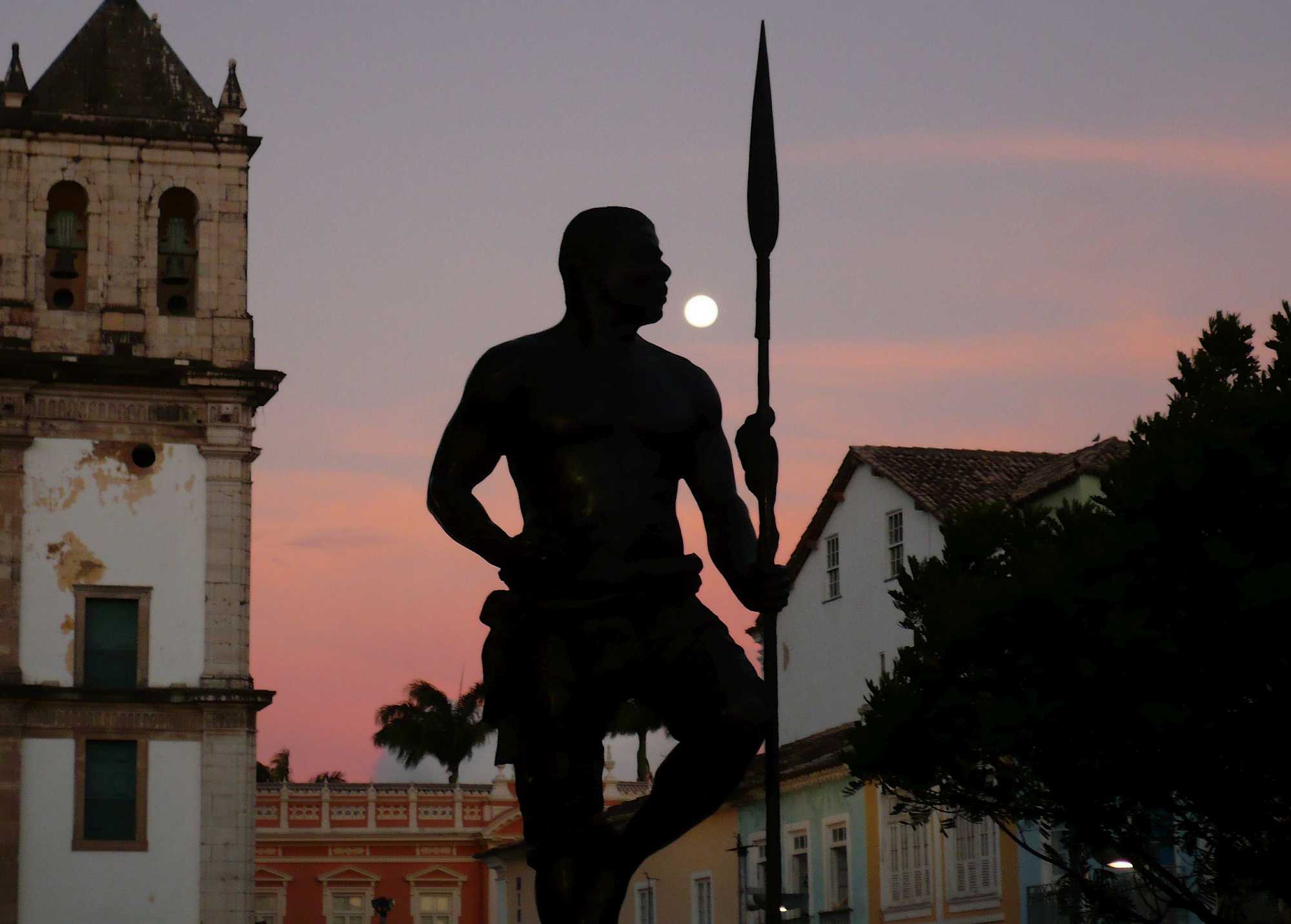The Quilombo dos Palmares was a nation of fugitive slaves, Indians, and a few whites that thrived throughout the full span of the 17th century. It was at almost constant war with two of the greatest empires on earth.
It had a quasi-parliamentary government, a complex defense system, a standard of living higher than that of most Europeans on the coast, and an egalitarian society that respected women and all races. Its last king, Zumbi, is reputed to have been well educated, having been raised by a Jesuit.
The population of Palmares may have reached or exceeded 20,000. Its citadel fortress atop a remote mountain was finally overrun in 1694, and today, nothing – not one artifact – remains.
Here is the introduction to Quilombo dos Palmares: Brazil’s Lost Nation of Fugitive Slaves, by Glenn Alan Cheney. For more information on New London Librarium’s Brazil Series on the history, culture, literature, and issues of Brazil, see NLLibrarium.com/brazil
Introduction to Quilombo dos Palmares: Brazil’s Lost Nation of Fugitive Slaves
Sometime in the late 16th century, forty “rebellious Negroes” are said to have somehow escaped captivity at a sugar mill near Porto Calvo in the captaincy of Pernambuco in northeast Brazil.
Sebastião da Rocha Pita, the Brazilian historian who reported this incident more than a hundred years later, gave no details of the escape, whether it was a violent uprising of slaves armed with no more than the tools of their trade – machetes, axes, hoes, scythes – or a silent slipping away into the dark of night.
He did not report whether women and children joined the exodus, whether anyone took food or tools, whether they ran with shackles on their ankles. About all we can surmise is that they ran in bare feet and instinctively headed west, away from the coast – away from the civilization that had enslaved them – and into the dense mata atlântica forest.
The forest and terrain worked to the advantage of people who carried little and had no destination other than away. At the same time, nature hindered anyone carrying weapons, ammunition, armor, supplies, and chains. The people fleeing could go in any direction; the people chasing them had any number of directions to choose from, only one of which was correct. Even barefoot people in the remnants of shackles could outrun soldiers lugging the baggage of war and enslavement.
The fugitives, who could have been Africans or Indians, ran until they reached the hills of the interior – steep, long ridges that punched up out of generally level terrain. Like fugitives everywhere, they found security in the higher elevations. They settled in a place of palm trees, fertile soil, plentiful water, and an abundance of game.

Over the years, more fugitives arrived, some quite likely from Bahia, the captaincy to the south. The population grew to hundreds and, by the turn of the century, thousands. Palmares became known to the Africans as a quilombo, from a word in the Mbundu language of Africa that meant war camp.
Settlements grew into villages, and more villages took hold on more mountains. Sharing a common purpose, common problems, and a common enemy, the villages – called mocambos, a Mbundu word for hideout – formed relationships that would evolve toward a common government. The polity became known as Palmares for the region’s many palms.
Palmares became a refuge for more fugitives, and its men became bold enough to attack farms and sugar mills to steal what they needed and to liberate more slaves. By 1603, Palmares was a problem that the Portuguese colonizers knew they had to resolve. A society dependent on slavery could not survive alongside a society of former slaves.
Palmares thrived while the colony on the coast struggled against disease, corruption, and the inefficiencies of an autocratic, hierarchical government led by a distant king. While Pernambuco depended on slavery, the nation of fugitives proved that free people, even free black people, could sustain themselves without agricultural commodity production based on forced labor.
Having formed a government and a religion that served its purposes, Palmares proved that the New World did not need the king of Portugal or the pope of Rome. Palmares also became a community of several races, not just blacks and Indians but whites who were fleeing society or the law. Palmares was a viable alternative to plantation slavery and Portuguese society.
It was an attractive nuisance that lured slaves away from slavery and gave European plebeians reason to question the status quo. It was also an aggressive enemy that threatened public safety and the colonial economy. It had to be eliminated.
Over the next ninety years the Portuguese and, briefly, the Dutch, sent two dozen military excursions to Palmares with the objective of exterminating it. To say that these militias were “white” or European would not be accurate, though they were defending white European interests.
Their ranks included black slaves and regiments of free blacks and free Indians. Judging by race alone, it would be hard to distinguish the defenders of the “black” nation from the defenders of the “white” outpost of Europe. The real battle was not only between an empire and rebels but between the wealthy and the poor, the enslavers and the free, the feudal past and an enlightened future that no one had even dreamed of yet.
Almost all the Dutch and Portuguese excursions failed miserably until 1694, when a massive army, much of it mercenaries of mixed race, surrounded the Palmarian citadel of Macaco. After a month-long siege, they killed, captured, or dispersed its defenders, effectively eliminating Palmares as a nation, effectively erasing it from the face of the earth.
Today, not one bit of physical evidence remains from Palmares. The precise locations of all but one of its villages and cities are unknown. Historical information about Palmares depends entirely on documents produced by the invaders, and their version of reality is suspect.
They recorded little about the society they were attempting to render extinct, and their reports were corrupted with ulterior motives. They had no concept of history, culture, or sociology, no interest in Palmares except its elimination. They wanted it not just dead but forgotten.
But Brazil did not forget. The memories of the Quilombo dos Palmares evolved into myths, and the myths fed into the political dialectic. Just as Palmares had offered an alternative to colonial society of the seventeenth century, it offered an alternative to socioeconomic problems of the 20th century.
As a people on the losing end of civilization’s perpetual struggles, the rebel nation was a useful symbol for later generations who opposed military rule, capitalism, class division, racism, and injustice. Thus myth became confused with fact, and, true or not, became an active and ongoing argument in the modern Brazilian culture.
Palmares was the largest and one of the most long-lived quilombos in Brazil but by no means the only one. There were thousands, and thousands remain in Brazil today, far-flung communities of people with complexions darker than average who still share communal land as their ancestors did.
Many of these communities are under siege just as Palmares was. The invaders aren’t militias but farmers, mining companies, developers, and others claiming land of undocumented ownership. The war that Palmares fought for nearly a century continues in myriad manifestations three centuries later.
This book recounts the struggle between Palmares and the European colonizers on the Brazilian coast. It depends extensively on the dubious documentation those colonizers left us. Those colonizers had little regard for the Palmarians as people or Palmares as a new and practical culture. The reports of militia commanders and government agents tend to focus on issues of battles, funding, and the threats Palmares represented.
They report precious little about the Palmares way of life, its language and religion, its people and their point of view. The reports are also tainted with political efforts to wrest money and privilege from higher powers. This book reports what they said happened.
The book goes on to explore the struggle in modern times. That struggle has evolved with the times, yet it is remarkably similar. And, similarly, the truth is still hard to discern. Archaeologists, historians, and sociologists find it hard to detach fact from myth.
Political activists struggle to use the symbol of Palmares to justify their positions. People who live in today’s quilombos struggle for recognition and respect even as they struggle to hold on to land that has been passed down to them.
A similar struggle, in fact, pervades Brazilian society, with its attempts to more equitably share revenues and land, provide justice for all, and, yes, still, end the modern equivalent to slavery.
Palmares was real, and its myths have become their own reality. The story and the history of Palmares are over 400 years old, and they have yet to reach their end.













